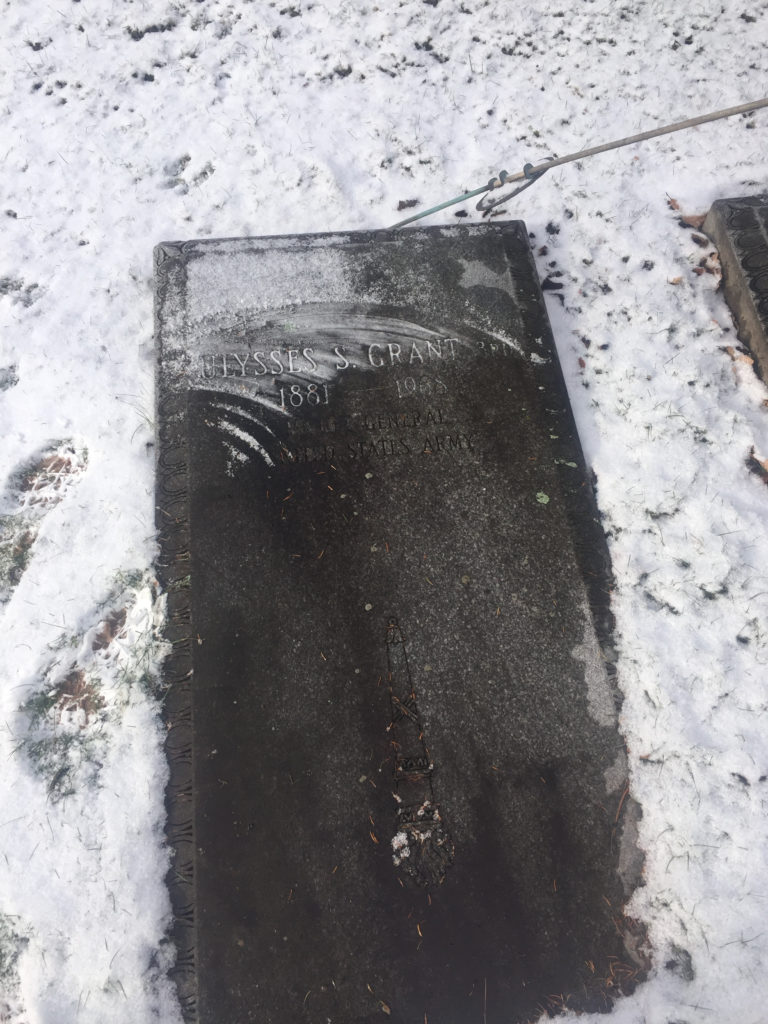Erik Visits an American Grave, Part 754
This is the grave of Ulysses S. Grant, III.

Born in Chicago in 1881, Grant grew up the grandson of the great general and less great president. He didn’t know his grandfather, being only 4 when he died, but surely lived in the shadow of the legend. His father was a diplomat and so Grant grew up in Austria. He went to Columbia University initially but then got a commission at West Point and transferred to the Military Academy. He graduated 6th in his class and was assigned to the U.S. Army Corps of Engineers.
Grant went on to a long military career as an engineer, at least after a brief stint in 1904 serving as an aide to Theodore Roosevelt, where he met and married the daughter of Elihu Root, truly solidifying his position in the Republican Party elite. He was involved in many of the colonialist wars of the era–in the Philippines, with the Marines putting down rebellion in Cuba, in the unjust attacks on Mexico during the Wilson administration, including at Veracruz and against Villa.
Grant was promoted to major in World War I and was on the staff of General Tasker Bliss at the Supreme War Council in Versailles, where Grant served as secretary. After his time helping out with the end of the war, Grant went back to the U.S., being assigned to California, where he dealt with some of the unresolved engineering issues around the state being filled with debris from gold rush miners hosing down mountains to uncover the color. Later, he really became almost a senior dignitary, maybe because of his skill, maybe because of his name. Did it look good to the public to name Ulysses S. Grant III to head the Office of Public Buildings and Public Parks in Washington? Yes, certainly it did. He was no doubt qualified, probably so were a lot of other officers. While in that role, he became highly concerned with the idea of couples “petting” in the parks and he tried to crack down on that sin.
In 1934, Grant started working for the Civilian Conservation Corps as commander of the 1st Engineering Regiment based out of Delaware, which might be the first time America’s most useless state has come up in this series, unless I have discussed the inventor of toll booths. Grant kept rising up the ranks, was chief of staff at Fort Jay on Governors Island, heading the Great Lakes Engineering Division out of Cleveland, and being named brigadier general in 1940.
As the nation headed to World War II, Grant, who was near retirement, continued working. He first commanded the Engineer Replacement Training Center at Fort Leonard Wood until mid-1942. He was then named head of the Protection Branch of the Office of Civil Defense. This was a real job, but it was also basically a PR job, which allowed him to travel the country and give talks about civil defense. Grant retired from the Army in 1946.
After the Army, Grant continued as a sort of ceremonial figure and not for the best. He was VP at George Washington University from 1946-51 for no apparent reason. He took a civilian role in the National Capital Park and Planning Commission. He was a trustee for the National Trust for Historic Preservation. To his credit, he testified against the building of the Echo Park Dam in Dinosaur National Monument, giving a lot of credit to the movement to save that beautiful spot from the dam builders, since it was the Army Corps doing it and that was Grant’s home.
On the other hand, Grant became very involved in the commission to commemorate the centennial of the Civil War, chairing the Civil War Centennial Commission from 1957-61. By this time, Grant was an old dude. The civil rights movement was growing. And he was absolutely hopeless. Grant was a huge supporter of Joe McCarthy and saw any of this civil rights mess as communist influenced. He was a big ally of the southerners on the commission who wanted to make sure that nothing about slavery was discussed in the commemoration. When some thought that the inclusion of Walter Reuther on the commission would be a good idea to get organized labor on board, Grant vetoed it because he felt that the UAW head was a red. As Grant was hanging out with his segregationist friends and opposing civil rights, Eisenhower was calling in the National Guard in Little Rock. The challenges to the Dunning School of Civil War history was really picking up. Grant was utterly unable to deal with this at all. The old man started taking heavy criticism for his pro-Confederate agenda. He got real bitter about it too. He finally resigned in protest in 1961 and the Civil War Centennial Commission was a big flop. He finally died in 1968, at the age of 87, though seemingly 136 given his social views.
Ulysses S. Grant III is buried in Hamilton College Cemetery, Clinton, New York.
This grave visit was sponsored by LGM readers. Many thanks to all of you who keep this series alive! If you would like this series to visit other descendants of presidents, you can donate to cover the required expenses here. Robert Lincoln is in Arlington and Dick Taylor, son of Zachary and traitor in defense of slavery, is in New Orleans. Previous posts in this series are archived here.


